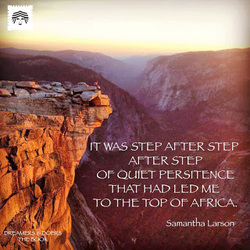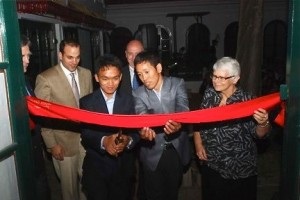|
Read in BBC Travel
On 1 October, 1973, Steven Fuller, his wife Angela and their infant daughter settled into their new house in Yellowstone National Park, just as the first flurries of the season were beginning to fall. Snow would soon dust the entire valley: the trees, the canyon walls and the spaces between the plumes of steam that rose from the hot springs, fumaroles and geysers. The changing season also would lead to a changing soundscape: the roar of summer’s tourist traffic would be reduced to a trickle, barely audible beneath the crashing waterfalls of the Yellowstone River. By the middle of November, the first blizzard would happen, covering the roads so thoroughly that the Fuller family would be all but locked within the park until spring – at least 16 miles away from their nearest neighbours. Fuller would then start the job that had brought them there. As Yellowstone’s Canyon Village winterkeeper, he was responsible for looking after the facilities and buildings over the cold season to ensure they would be in good shape come spring and summer. Published in RootsRated
Gerlinde Kaltenbrunner has a gentle presence. Her voice, shaped by an Austrian accent, is soft; her words chosen through a thoughtful, compassionate disposition. But make no mistake about it: In the world’s highest mountains, this woman is a force of nature. After reaching the top of K2 in 2011—after six summit attempts over four expeditions—she became the second woman to have climbed each of the 14 peaks above 8,000 meters, and the first to have done so without the use of supplemental oxygen. Before she comes to Olympia to speak at the Washington Center on Friday, February 19, RootsRated had the chance to speak with Kaltenbrunner, 45, about her climbing philosophy, coping with tragedy in the mountains, and the relationships she forms with every peak she climbs. Here’s what she had to say. Spirits were high at Mount Baker Ski Area last Saturday as skiers and snowboarders trickled in to the resort’s White Salmon Lodge after a day on the slopes. The day was bright and clear and the mountain was still laden with the snow from December’s winter storms. But the après-ski fare was a little gloomier than you might expect: a talk about a phenomenon that has potential to kill off the very activity they came here for.
It was the first of a three-part lecture series by University of Washington scientists about global warming in the Pacific Northwest. The brainchild of UW ocean scientist and longtime Baker skier Sarah Myhre, the “1.5 Degrees Series,” named for the target set at the recent United Nations climate summit in Paris to limit warming to just 1.5°C, aims to bring climate science directly to people who have a vested interest in fighting it. Published in RootsRated.
If you have ever rock climbed—and even if you haven’t—chances are you’ve heard of Alex Honnold. Sprung into global fame by his free solo (rope-less) ascents of epically difficult routes like the Regular Northwest Face of Half Dome and El Sendero Luminoso in Mexico, Honnold, 30, has climbed all over the world, from crumbly desert towers, to big granite walls, to big mountains. In his new book, Alone on the Wall, co-written with author and climber David Roberts, Honnold recounts the stories behind his big feats—which, he hopes, will show the world that despite his radical audacity and superhuman athleticism he is, in fact, a real person. Now at the start of his rapid-speed cross-country book tour, which is coming to Seattle onNovember 19 and December 3, RootsRated got the chance to talk with Honnold about writing Alone on the Wall, his biggest climbs, and whether he ever still gets scared while climbing. Here’s what he had to say. Published in Smithsonian.com
Austria is a country defined by mountains: Well over half of its landscape is shaped by the iconic Alps. A night spent in Innsbruck, the capital city of Tyrol (the state in which Austria’s highest peaks are found), is full of constant reminders of the summits above: crisp mountain air, cool temperatures, the sound of periodic rock fall. Many Austrians spend their weekends and holidays exploring the higher climes. They hike past lush alpine dairy pastures and pristine lakes in the shadow of rocky spires. And at the end of each day, they enjoy a hearty meal, hot shower and night’s rest at a scenic hütte (hut). There are more than 1,000 hütten scattered through the Eastern Alps, most of which are associated with either the Austrian Alpine Club or German Alpine Club. While a summer hiking in the Austrian Alps might sound like the sort of vacation best suited for serious adventurers, the clubs were founded in 1873 with the mission to make the peaks accessible to all. As Henrich Stenitzer, a prominent club member, wrote in 1912, “The alpine clubs have unlocked the majesty and beauty of the high mountains for the masses, giving countless numbers of people the opportunity, without prohibitively demanding effort…or exorbitant costs, to become acquainted with the Alps.” Published in RootsRated.
It’s still dark on the drive to the cliff, but the climbers in the car are already wide awake in anticipation of the morning’s session. Seattle-based climber Audrey Sniezek is behind the wheel, calmly steering as she chats with her partners—the “morning crew”, as they call themselves—en route to Little Si, their favorite sport-climbing crag. When they pull into the parking lot, theirs is the only car in sight. With multiple 5.14s under her belt, Sniezek, 42, is one of the top female climbers in the country—and she gets it done while maintaining her career as a high-level software engineer. Hence the pre-dawn start just to climb at the local crag: It’s Sniezek’s way of fitting in the time she needs to stay on top of her game. Sniezek has been climbing in the early mornings at little Si since 2005. “It’s the perfect training cliff, it’s relentless,” she says. “Every time I come here I learn something new about myself.” At this point she has ticked off many of the crag’s hardest routes, but Sniezek says she had been climbing for 10 years before she realized her full athletic potential—and figured out how to reach it while still balancing climbing with a demanding career. RootsRated had the chance to talk with Sniezek to get her top tips for climbing at your best, even in the throes of a busy life. Here’s what she had to say. Published in RootsRated.
When Christopher McDougall’s book Born to Run became a national sensation, its star, ultrarunner Micah True, also known as Caballo Blanco, or “White Horse,” went from unknown recluse to household name—and his fame was further heightened by hisunexpected death in 2012. But beneath the legend of Caballo Blanco was an authentic, down-to-earth man, a story that Seattle-based filmmaker Sterling Noren aims to convey in his new documentary, Run Free: The True Story of Caballo Blanco, which offers a fascinating look into Micah True’s real, yet no less remarkable, life. As part of its U.S. tour, Run Free will show at the Capitol Theater in Olympia on Oct. 6, and at The Mountaineers in Seattle on Oct. 7, the second of which will be followed by a live Q&A with Sterling Noren and Seattle-local “Barefoot” Ted McDonald. RootsRated had the chance to sit down with Noren about his favorite local places to run, how he and True met, and the film’s backstory—including how he carried on after the tragic passing of Caballo Blanco midway through the project. Here’s what he had to say.
For Fix.com
While it is hard to imagine how a simple roll of gray tape could be so mighty, duct tape is famous for its uncanny ability to fix just about anything. If you’re planning some quality time outside – where you may be far from the conveniences of modern life – having the necessary supplies for self-reliance is a must. Throw some duct tape in your pack and you’ll be prepared for everything from clothing repairs to first aid solutions and fire starters, with a catchall survival tool for whatever sticky situations may arise. A History of AdherenceWhat we now call duct tape was first developed during WWII as a handy way to seal cases of ammunition (soldiers wanted a waterproof material that was strong, easy to slap on, and quick to tear off). It didn’t take long for soldiers to experiment with uses of the new invention, which they nicknamed “duck” tape (both because it is waterproof, like a duck, and because it’s made from duck cloth). Soldiers reportedly used it for vehicle and aircraft repair, as a temporary means to close wounds, and as a general all-around quick fix-it. After the war, the soldiers brought their love of duck tape from the battlefields to the home front.  Some said I was too young. But I think the fact that I was just twelve years old when I went to Tanzania and climbed Kilimanjaro with my dad meant that I still had that fleeting openness to life that comes from having a mind that is not yet fully formed. The scenes and experiences I took in over the course of that trip shaped me in a way that still persists today. I wrote a bit about what climbing Kilimanjaro meant to me in my story, “Discovering a Certain Grandness of Life,” for Dreamers and Doers. This is a collection of stories, published by the Ladies Trekking Club, by women from across the world whose lives have in some way been shaped by the fact they climbed to the top of Africa; it is an anthology that is edifying, enlightening, and inspiring. But it’s not actually necessary to travel halfway around the world in order to learn most of the personal lessons that we wrote about. Many of the benefits of travel and adventure can come from simply opening and reading a book. This is the gift this project aims to give to many children who have grown up living in the shadows of Kilimanjaro: every copy of Dreamers and Doers sold provides for a textbook that will be donated to a Tanzanian school. Take part in these ladies’ adventures and give the gift of education by ordering a copy of Dreamers and Doers here. Hundreds of yellow, red and blue specks quickly appear every April in the valley below the 18,000-foot summit of Kala Patthar, one of Nepal’s most popular hiking destinations. The spots are clustered on a rocky field at the edge of the snow and ice that lies in the shadows of the world’s greatest monolith, Mount Everest. They are tents that make up a temporary village known as Everest base camp. In the spring of 2008, Michael Kobold hunkered down in one of these tents and, under the curious gaze of Ang Namgel Sherpa, assembled a mechanical watch. The owner of Kobold Watches, Michael hatched his scheme to start a watch company a decade earlier during a class project at Carnegie Mellon University; he decided to continue the venture after the class ended, essentially because he didn’t much like college and was bored. He founded the company with $5,000 when he was 19, working out of his apartment in Pittsburgh. It proved to be successful beyond expectation — in the first year he grossed $85,000. His watches now sell for as much as $10,500 each and can be found on wrists ranging from Bill Clinton’s to Bruce Springsteen’s. “I’m still sort of amazed,” Michael says. “I didn’t think I’d be running my own watch company for more than two semesters.” |
Samantha's
Archives
July 2016
Categories
All
|

 RSS Feed
RSS Feed